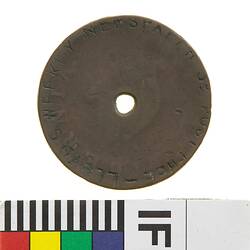Summary
Copper Halfpenny Irish, surcharged Token, mint unknown, circa 1806. It was surcharged by Lloyd's Weekly Newspaper, circa 1855. Although the newspaper was sold in Australia, it is most likely that the tokens stamped 'LLOYDS WEEKLY NEWSPAPER 3D POST FREE' found their way to the colonies in the pockets and purses of British immigrants and were readily absorbed by the colonial economy, which at the time was desperately short of official currency.
Founded by the British publisher Edward Lloyd (1815-1890), Lloyd's Weekly Newspaper was originally issued from 1842 as Lloyd's Illustrated London Newspaper, it initially sold for two pence, a third the sixpence cover price of its main rival the Illustrated London News. Lloyd had kept the price low by publishing the newspaper illegally without paying the required stamp duty, but after seven weeks was forced to relaunch the publication as Lloyd's Weekly London raising the price to threepence to cover the duty. It soon became one of Britain's first mass market newspapers. In 1849, it was renamed Lloyd's Weekly Newspaper, providing an earliest likely date for these tokens. By 1853, circulation had reached 90,000 copies a week. In 1860 Lloyd dropped the price back to one penny and circulation rose to 500,000 copies by 1872. In 1896, six years after Lloyd's death, it became the first newspaper to regularly sell one million copies an issue. Lloyd spent large amounts of time and money promoting the newspaper, with one of his ploys being to pay his staff in coins stamped with the publications name, although this practise was later declared to be illegal under the Coinage Act 1861.
Physical Description
Irish Halfpenny, c. 1806 surcharged LLOYDS WEEKLY NEWSPAPER 3D POST FREE on both sides
Obverse Description
British Halfpenny, c. 1806 surcharged LLOYDS WEEKLY NEWSPAPER 3D POST FREE
Reverse Description
British Halfpenny, c. 1806 surcharged LLOYDS WEEKLY NEWSPAPER 3D POST FREE
More Information
-
Collecting Areas
Migration & Cultural Diversity, Numismatics & Philately, Working Life & Trades
-
Acquisition Information
Transfer from National Gallery of Victoria (NGV), 15 Mar 1976
-
Date Issued
circa 1855 AD
-
Issued By
-
Inscriptions
Obverse: LLOYDS WEEKLY NEWSPAPER 3D POST FREE Reverse: LLOYDS WEEKLY NEWSPAPER 3D POST FREE
-
Denomination
-
Material
Copper
-
Classification
-
Category
-
Discipline
-
Type of item
-
Dimensions
28 mm (Outside Diameter), 7.58 g (Weight)
holed
-
Shape
Round
-
References
[Book] Andrews, Arthur. 1921. Australasian Tokens and Coins., No. 1155
-
Keywords


